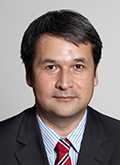
28 Dec Cancers Attributable to Obesity Vary by State
MedicalResearch.com Interview with:

Dr. Islami
Farhad Islami, MD PhD
Scientific Director, Surveillance Research
American Cancer Society, Inc.
Atlanta, GA 30303
MedicalResearch.com: What is the background for this study?
Response: Despite variations in excess body weight (EBW) prevalence among states in the United States, there was little information on the proportion of incident cancers attributable to EBW (or population attributable fraction, PAF) by state. This information would be useful to help states set priorities for cancer control initiatives.
In this paper, we estimated the PAF and number of incident cancer cases attributable to EBW by sex in all 50 states and the District of Columbia using representative exposure and cancer occurrence data. To provide more accurate estimates, we adjusted state-level data on body mass index (BMI) based on self-reported weight and height from the Behavioral Risk Factor Surveillance System by sex, age group, race/ethnicity, and education level (162 strata) using BMI values from the National Health and Nutrition Examination Survey, a nationally representative survey with objectively-measured height and weight.
MedicalResearch.com: What are the main findings?
Response: We found that each year, about 37,670 cancer cases in men (4.7% of all cancer cases excluding non-melanoma skin cancers) and 74,690 cancer cases in women (9.6%) aged ≥30 years in the United States were attributable to excess body weight during 2011-2015. By state, the PAF in men ranged from 3.9% in Montana to 6.0% in Texas and in women from 7.1% in Hawaii to 11.4% in the District of Columbia. The highest PAFs were found in several states in the South and Midwest, plus Alaska and the District of Columbia, and the lowest PAFs were found in the Mountain and New England regions and Hawaii. The PAF was far greater for some individual cancer types. For endometrial cancer, for example, the proportion ranged from 36.5% in Hawaii to 54.9% in Mississippi and was 50.0% or more in 19 states.
MedicalResearch.com: What should readers take away from your report?
Response: Prospective cohort studies have shown that adherence to comprehensive guidelines on weight, nutrition, and physical activity, including those of the American Cancer Society, reduces the risk of total cancer incidence and mortality. However, many Americans do not meet the recommendations. It should be noted though that individual behavioral choices often occur within the context of the community. Thus, to reduce the obesity epidemic, primary prevention interventions should be broadly implemented at both individual and community levels to promote healthy diet and physical activity. Examples of community level interventions include reducing access to and marketing of unhealthy foods (e.g., through a tax on sugary drinks), promoting and increasing access to healthy foods and physical activity (e.g., through zoning and licensing regulations and incentive programs in underserved areas), and preventive care.
MedicalResearch.com: What recommendations do you have for future research as a result of this work?
Response: Currently, excess body weight is known to be associated with 13 cancer types. Further research is needed on the association between EBW and other cancers types, as well as on mechanisms underlying the association between EBW and cancer. More research is also needed to identify tailored, more efficient, and mutually reinforcing interventions, particularly for underserved populations, as excess body weight is more common in lower socioeconomic groups in the United States
MedicalResearch.com: Is there anything else you would like to add?
Response: Increases in obesity prevalence over the past 4 decades strongly suggest that the burden of excess body weight in the United States will be even higher in the decades to come, further underscoring the importance of reducing the obesity epidemic.
Disclosure: All authors report being employed by the American Cancer Society, which received a grant from Merck for intramural research outside of the submitted work; however, the authors’ salaries are solely funded through the American Cancer Society.
Citation:
[wysija_form id=”3″]
[last-modified]
The information on MedicalResearch.com is provided for educational purposes only, and is in no way intended to diagnose, cure, or treat any medical or other condition. Always seek the advice of your physician or other qualified health and ask your doctor any questions you may have regarding a medical condition. In addition to all other limitations and disclaimers in this agreement, service provider and its third party providers disclaim any liability or loss in connection with the content provided on this website.
Last Updated on December 28, 2018 by Marie Benz MD FAAD
